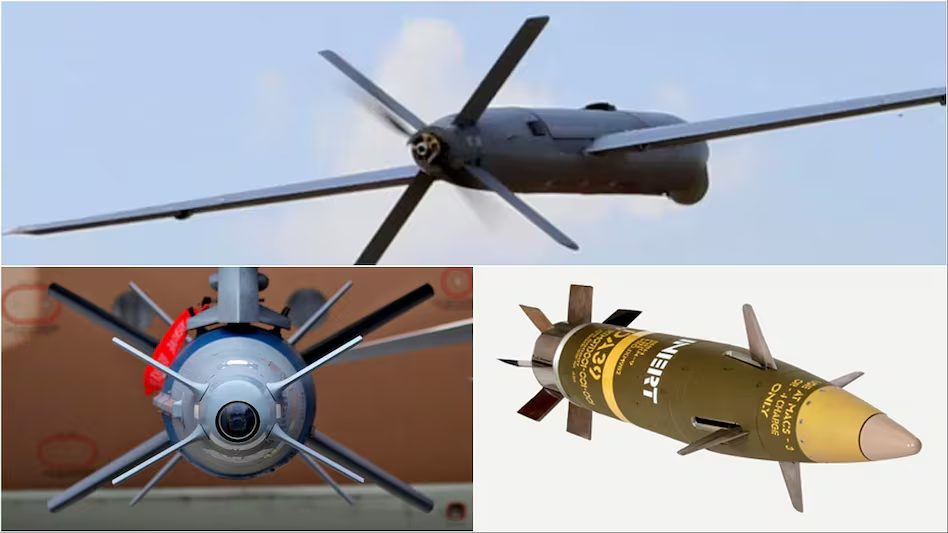Table of Contents
In a high-precision pre-dawn aerial strike code-named Operation Sindoor, Indian Armed Forces bombed several terror training camps deep in Pakistan and PoK, showing a sharp intensification of India’s counter-terrorist war. The operation, carried out with war-room level strategy coordination among the Indian Air Force, Army, and Navy, demonstrated India’s state-of-the-art military muscle.
One of the operation’s strengths was the advanced weaponry used by India, such as SCALP and HAMMER missiles launched from Rafale fighter jets and kamikaze drones (loitering munitions) for reconnaissance and strike missions. A thorough discussion of the weapons used during Operation Sindoor is presented below.
Weapons Used in Operation Sindoor
India’s Operation Sindoor, launched on May 8, 2025, was a decisive counter-terror mission against 21 terror camps in Pakistan and PoK. The operation demonstrated India’s capabilities in advanced precision strikes by fusing next-generation missiles and drones. From deep-penetration cruise missiles to loitering munitions, the Indian Armed Forces employed a combination of indigenous and foreign weapons systems to achieve precision, speed, and strategic triumph while reducing collateral damage.
| Weapon System | Type | Purpose |
|---|---|---|
| SCALP Missile | Long-range cruise missile | Struck deep terror infrastructure in Pakistan |
| HAMMER Missile | Precision air-to-ground | Targeted medium-range mobile and fortified targets |
| BRAHMOS Missile | Supersonic cruise missile | Used for rapid, bunker-busting strikes |
| METEOR Missile | Beyond Visual Range AAM | Protected Indian airspace during the operation |
| Loitering Munitions | Kamikaze drones | Real-time surveillance and autonomous strikes |
Details of Weapons Used in Operation Sindoor
Operation Sindoor, conducted by the Indian Military, was a counter-terror operation targeting terrorist camps in Pakistan and PoK. It highlighted India’s sophisticated airstrike capacity with precision-guided weapons. The operation utilized everything from deep-penetration cruise missiles to loitering munitions and high-speed supersonic systems and emphasized seamless integration across the Air Force, Navy, and Army. Here is a detailed table showing the main weapons utilized during Operation Sindoor, their characteristics, source, and utilization during the mission.
| Weapon | Type | Origin | Range | Key Features | Role in Operation Sindoor |
|---|---|---|---|---|---|
| SCALP (Storm Shadow) | Long-Range Cruise Missile | France (MBDA) | ~450–500 km | Terrain-hugging flight, stealth, INS + GPS guidance, high accuracy | Targeted deep, fortified terror bases with high-value bunkers |
| HAMMER | Precision-Guided Bomb | France (Safran) | ~70 km (modular) | All-weather, GPS/IR/laser guidance, jamming-resistant, adaptable | Struck medium-range terror assets and mobile targets with precision |
| BRAHMOS | Supersonic Cruise Missile | India-Russia | ~450–500 km (modern) | Mach 2.8–3.0 speed, fire-and-forget, low-altitude strike, 200–300 kg warhead | High-speed bunker-busting attacks on high-value targets |
| METEOR | BVRAAM (Air-to-Air Missile) | Europe (MBDA) | >100 km (No-Escape Zone) | Active radar homing, solid-fuel ramjet engine, advanced ECCM | Ensured Indian air superiority, neutralized airborne threats |
| Loitering Munitions | Kamikaze Drones | Indigenous/Imported | Variable (10–100+ km) | Real-time surveillance, autonomous/semi-autonomous strikes, mobile target focus | Struck time-sensitive targets; supported real-time recon and surgical attacks |
List of Weapons Used in Operation Sindoor
HAMMER Missile – Tactical Precision Airstrike Weapon
| Feature | Details |
|---|---|
| Full Form | Highly Agile Modular Munition Extended Range |
| Origin | France |
| Type | Air-to-Ground Precision-Guided Munition |
| Range | Up to 70 km |
| Integrated With | Rafale Fighter Jets |
| Key Features | – Precision in all-weather conditions – Resistant to jamming – Effective at low altitudes and rough terrain – Autonomous targeting |
| Role in Operation Sindoor | Used for medium-range strikes on terrorist camps with minimal collateral damage. Enabled pinpoint accuracy in tactical missions. |
Why These Weapons Matter
Operation Sindoor showcased India’s technological advancement and strategic shift toward network-centric warfare. Each weapon system was chosen to:
-
Maximize targeted lethality
-
Minimize civilian damage
-
Overcome terrain and electronic warfare hurdles
Together, these platforms created a multi-layered attack system—integrating air superiority, deep strike, real-time reconnaissance, and high-speed engagement.
Conclusion
Operation Sindoor is a confident assertion of India’s no-tolerance policy against terrorism. The finely chosen combination of HAMMER, SCALP, METEOR, BRAHMOS, and Kamikaze drones is a testament to India’s dedication to precision, professionalism, and deterrence.
These arms not only guaranteed the success of the operation but also demonstrated India’s increasing defence self-sufficiency and tactical finesse on the world stage.


 Miss Universe Winners List From 1952 to ...
Miss Universe Winners List From 1952 to ...
 Significance and History of Diwali Festi...
Significance and History of Diwali Festi...
 Asia Cup Winners List (1984–2025): Ind...
Asia Cup Winners List (1984–2025): Ind...

























